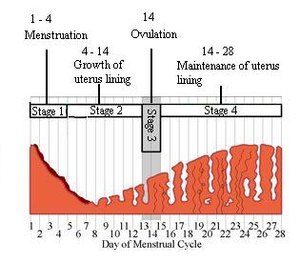How to Track Your Ovulation When Trying to Conceive
Ovulation is the release of an egg from the ovary. When you ovulate, you are ‘in the game’ so to speak – and if you win, you conceive a pregnancy! Thus, learning how to track your ovulation is essential to maximizing your chances in trying to conceive.
The menstrual cycle (which lasts an average of 28-30 days, but could vary from person to person), is centered around the ovulation of an egg into the Fallopian tube, which connects the ovary to the uterus. If an egg is fertilized by sperm it may slowly develop into an embryo over the course of a week, making its way toward the uterus where it can then implant and grow into a pregnancy. If the ovulated egg doesn’t result in a pregnancy, the estrogen and progesterone coming from the ovary where the egg was released) plummet and the lining of the uterus breaks down and sheds, leading to a period. Understanding when you ovulate is KEY because the egg, once it’s released, has a very short ‘shelf-life’– if it doesn’t get fertilized within 12-24 hours, it will die off and you have to wait until your next ovulation window to try again. Unlike the short-lived ovulated egg, sperm can survive for longer in the reproductive tract- up to 3-5 days in the reproductive tract. Therefore, getting sperm into the reproductive tract (via sex or insemination) in the 2 day window prior to ovulation is key. Being exposed to sperm on the day of, or after, ovulation, has lower odds of pregnancy. Since there are so few days each month/cycle that constitute ‘the fertile window of opportunity’, it is so important to know when you ovulate.
When do you ovulate?

The key to learning how to track ovulation is based on the fact that most women will get their period ~2 weeks after ovulating, if the ovulated egg doesn’t result in pregnancy. In a woman with a regular 28 day cycle, where ‘day 1’ is the first day of full flow menstruation, you would expect that ~day 14 of the prior cycle was when ovulation took place. Relying on this method to estimate the timing of future ovulations is contingent on having a regular, predictable period. If you have a regular cycle, you can predict the next fertile window since it should fall around the same time each month. In women with irregular cycles, the differing and unpredictable intervals between periods can make it impossible to accurately anticipate when ovulation is taking place. In these instances, it is best to speak with your doctor early on, to figure out why your cycles are irregular and how to best determine timing of ovulation. Aside from relying on your menstrual pattern to project when ovulation will take place, there are also physical signs and symptoms of that can help determine when you are ovulating.
Physical signs and symptoms of ovulation
The menstrual cycle is a series of coordinated steps that revolve around the build up to ovulation and it’s resolution, resulting in either pregnancy or a period.
Day 1 of full flow bleeding to the the day of ovulation is known as the ‘follicular phase’. During the first half of the menstrual cycle, the pituitary gland in your brain sends signals to the ovary and the first egg to respond will mature and eventually ovulate that cycle. As the egg is growing and maturing, estrogen levels rise, causing vaginal discharge to become watery and clear. As the egg matures, the fluid-filled follicle holding the egg enlarges and swells, which may be associated with pelvic cramping on the side where ovulation is about to take place. When the egg bursts from the fluid filled follicle, this is ovulation. This may be felt as an intense, cramp on one side of the lower abdomen or pelvis called mittelschmerz (that’s German for “middle pain”). After ovulation, the ovary begins to churn out progesterone, in addition to the estrogen it was already producing. The ~2 week period from ovulation until the start of the next period is called the ‘luteal phase’. Post-ovulation progesterone has a relaxing effect on the body – which can lead to sleepiness, constipation, ligament laxity, breast swelling and tenderness, and a slight rise in body temperature. Cervical mucus will thicken and may have an egg-white appearance. If the ovulated egg does not result in pregnancy, progesterone and estrogen levels begin to fall, leading to breakdown of the uterine lining and bleeding, which signals the start of the next menstrual cycle.
How to track your ovulation ‘window’:
Use a Calendar
In order to reliably predict ovulation and the 2-3 day ‘fertile window’ that comes right before ovulation. Counting backwards 2 weeks from the time you got your period as the time of ovulation in the prior cycle, you can determine the length of time between day 1 of your period and ovulation and use that information to accurately predict when you will ovulate in future cycles. There are many menstrual cycle tracking apps, that will do the math for you. This will only work for women with regular, predictable periods.
Ovulation Predictor Kits
These kits detect a hormone from the pituitary (a gland in the brain), called Luteinizing Hormone (LH). LH tells your ovary to release an egg. The LH signal can be picked up in one’s urine 12-24 hours prior to it actually resulting in ovulation. A positive ovulation predictor kit means you have about a day or so to get sperm into the reproductive tract. Note: Ovulation predictor kits won’t work for all women. For example, those with Polycystic Ovary Syndrome (PCOS) tend to have high levels of Luteinizing Hormone throughout the cycle, and therefore may have false positive ovulation predictor kits, falsely suggesting that they are about to ovulate all the time**.
Pelvic Ultrasounds and Bloodwork
If you have an irregular cycle, the most accurate way to determine what part of the cycle you are in and when ovulation is taking place is to have pelvic ultrasounds where a doctor can visualize whether there is an enlarged follicle (aka. fluid filled space that contains the egg) about to ovulate an egg. When the follicle measures at least 18mm in diameter, it is close to being ready to ovulate. Once the follicle starts growing, it will grow at a rate of ~1 to 2mm per day. Checking the levels of hormones such as estrogen and progesterone will also provide precise information about where you are in your cycle.
The first step on any woman’s fertility journey should be a thorough understanding of their menstrual cycle, and specifically knowing how to track your ovulation window. For women with regular periods, you can use any of the above techniques to help you isolate and predict your next ovulation window and maximize your chances to conceive without outside intervention. For those of you with irregular periods, I encourage you to speak with your physician to understand whether ultrasounds, bloodwork and/or other techniques can help you better track your ovulation window.
Dr. Lucky Sekhon
My name is Lucky Sekhon and I'm a double board-certified OBGYN, and Reproductive Endocrinologist & Infertility specialist practicing at RMA of New York. My mission is to empower women with practical and scientifically accurate information to make the right fertility decisions for themselves.
Follow me on Instagram to keep up to date with my fertility related posts and content.

